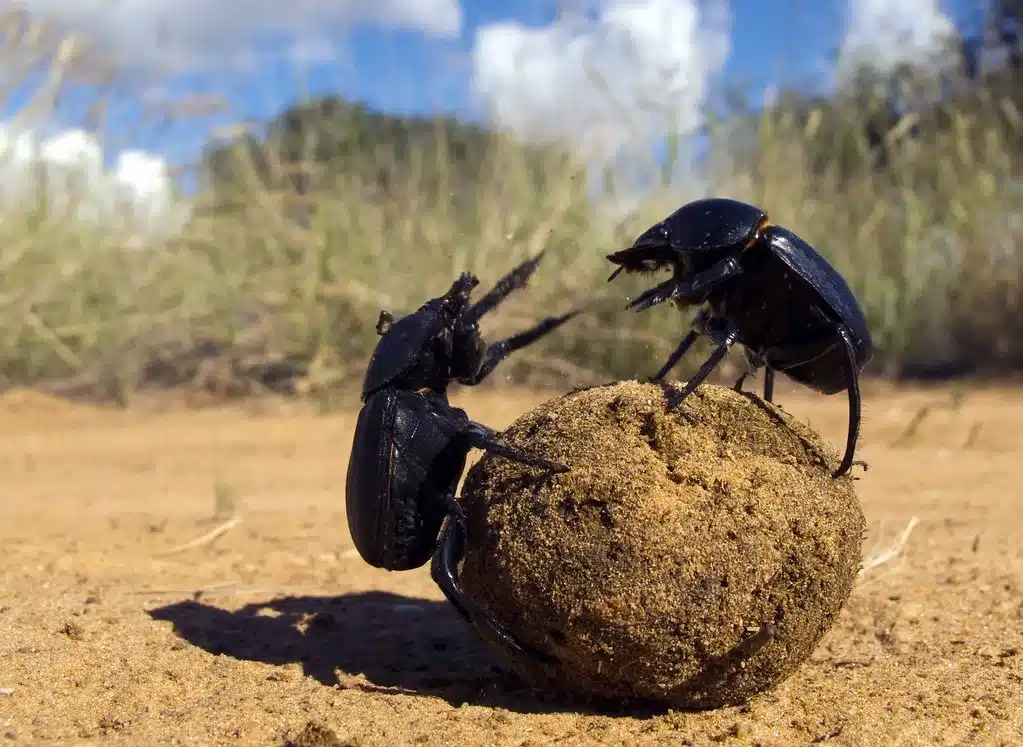Sustainable farming measures recognise the beneficial role played by insects, and dung beetles are one of the most helpful critters out there. Dung beetles have their name for a reason: the many species of dung beetles found worldwide spend their days breaking up, burying and rolling dung, which helps to put essential nutrients back into the soil, fosters plant growth and prevents a pasture from turning into a ‘cowpat-ure’.
Types of dung beetles
As a sub-grouping (Scarabaeinae), dung beetles are part of the Scarabaeidae family. There are more than 5,000 species of dung beetles worldwide. They are found on every continent but for Antarctica, and will thrive in all climates (except where there is extreme cold).
Dung beetles can be broken down into four distinct groups:
- Telecoprid – roll the famous balls of dung and bury them in soft soil
- Endocoprid – lay their eggs in a pile of dung
- Paracoprid – dig down below a pile of dung
- Kleptocoprid – steal the balls from the Telecoprids.
Why are dung beetles important to the environment?
During the summer season, dung beetles clean up the majority of animal dung in the wild. If it weren’t for dung beetles, animal dung would simply keep piling up. You can call them the ‘clean-up crew’ or the ‘Pooper Scoopers’!
In agriculture, dung beetles provide the same service by breaking down and burying cow dung. This not only fertilises the soil (thus providing better grass for grazing), but also saves the livestock industry millions of rands a year by improving animal health. In fact, according to a study conducted by the American Institute of Biological Sciences (AIBS) in 2006, dung beetles save the US livestock industry a staggering US$380 million annually.
Here’s how dung beetles save livestock farmers money
Dung beetles are important to the health of the soil and to the farmer’s bottom line, and having dung beetles in pastures is a sign of a healthy and productive land base. The main benefits to the farmer include:
Fly control
A cow can produce up to 12 cowpats a day. If left exposed on the ground, this faecal matter provides an ideal breeding ground for dangerous flies and parasites. In only two weeks, up to 3000 flies can breed on a single cowpat.
Dung beetles are dung burying ‘machines’, able to bury 250 times their own weight in dung per day. By burying dung, dung beetles prevent the growth of potentially harmful flies and parasites. They move flies’ eggs and brooding sites below the soil, thus breaking the life cycle of the flies.
Along with burying piles of poop, dung beetles that create dung balls (Telecoprids) excrete a chemical on the ball that will repel flies from trying to lay their eggs. Other varieties of dung beetle larvae will prey on the larvae of flies.
Improved pasture fertility
Dung beetles search for the most nutritious manure in the pile (this is what they ball up and roll away or bury directly under the cowpat). What’s left behind are the smaller, high-fibre pieces. The portions of dung that dung beetles seek are the highest in nitrogen; by burying these bits, the beetles move this matter to the rhizosphere in the soil. This means less nitrogen leaching back into the atmosphere, and more nitrogen for plant growth.
Water management and soil aeration
In the face of climate change, flood and drought cycles are affecting farmers around the world. They need sustainable, effective solutions to mitigate these risks.
Dung beetles continuously tunnel holes into the rhizosphere, aerating the soil and increasing the rate at which water can infiltrate the soil. In addition, by mixing with residual manure left over from the dung beetle larvae, water will lock into the rhizosphere like a sponge, giving plants perfect access to water right where they need it most.
By promoting a healthier water cycle, dung beetles help healthier plants to grow, encouraging more photosynthesis and more feed for livestock.
The Australian Dung Beetle ProjectCattle were only introduced to Australia in the 1880’s. The country has hundreds of species of native dung beetles, but these have evolved to use the dung of kangaroos and other indigenous mammals, which have a much more fibrous diet than cattle. The native beetles, therefore, are unable to break down the vast amounts of dung produced by newly-introduced livestock. The problem of accumulating cow dung became so severe in Australia that the Commonwealth Scientific and Industrial Research Organisation initiated the ‘Australian Dung Beetle Project’, which introduced dung beetle species from South Africa and Europe to Australian farms. The project monitored the effects of the dung beetles and found that pasture quality and fertility improved significantly. There was also a 90% reduction in localised bushfires since there was less flammable manure exposed on the topsoil. |
The bottom line
With diseases carried by flies costing farmers millions per year, introducing dung beetles is a sustainable way to drastically reduce fly populations and associated parasites and diseases. Add their ability to increase fertility in pastures and allow for more effective water cycling, and dung beetles can make a significant impact on farm financials. All you need to do is create the conditions for dung beetles to thrive.
Sustainable solutions start here
At Zylem, we focus on sustainable farming methods that improve long-term outcomes. We’ve seen the role that dung beetles can play in reducing costs and inputs, and we can help you foster conditions that promote dung beetle proliferation.
Find out more about our services and solutions
Contact us on 033 347 2893 or send your enquiry to [email protected].

About the Author: Alex Platt
Alex is Business Development Manager at Zylem. He’s inspired by the potential of regenerative farming and takes a special interest in the technology and products that are moving agriculture in a more sustainable direction.

